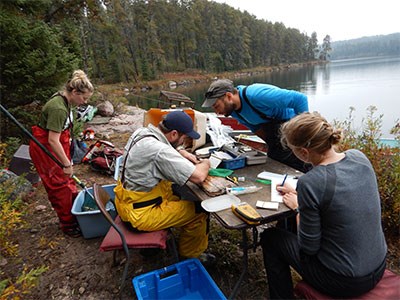For most of its 47-year existence, the public perception of the Experimental Lakes Area (ELA), southeast of Kenora, took on an almost Area 51 aura.
“People have known about ELA, but that’s about it,” said Matt McCandless, executive director of the International Institute for Sustainable Development (IISD), a Winnipeg policy think tank now operating the 27,000-hectare former federal research station. “They don’t know what happens about ELA or haven’t been able to see it. That’s something we set out to change.”
The shroud of secrecy is off. Public outreach and transparency is in.
And unlike their colleagues at the Fisheries and Oceans Canada, no gag orders apply to ELA researchers who are free showcase their work through educational programs and field tours, can engage with area First Nations, and can solicit ideas from outside scientists to keep the project pipeline going.
“We’re really making an effort to open up ELA to the community who want to know what’s going on and want to understand the research better,” said McCandless. “The value to this research is people knowing about it, and to make informed decisions.”
Experimental Lakes is an enormous petri dish of 58 small and deep lakes where entire ecosystems can be manipulated to answer the larger scientific questions of climate change, water contamination and agricultural runoff.
The facility is a child of the environmental movement in the 1960s.
The declining heath of the Great Lakes –specifically man-made impacts on Lake Erie – led the Canadian and American governments to select a remote site in northwestern Ontario in 1968. There, research could be done on entire lakes, specifically the impacts of eutrophication in aquatic environments, which are algae blooms caused by increased nitrogen, phosphate and potassium.
It still remains a cornerstone project at ELA.
The seminal acid rain studies performed there in the 1970s led to a Canada-U.S. treaty that curtailed airborne emissions.
The historic tug of war with its bureaucratic masters ultimately led to Ottawa pulling the plug on the ELA’s annual $2 million subsidy in 2012. The feds decided that research dollars are better spent on applied research with commercial outcomes rather pure science-driven work.
The threat that a unique facility could be closed down and decades of research scuttled spurred a lobby campaign that attracted international attention and led the IISD, a policy think tank 300 kilometres away in Winnipeg, to step in to ensure that the ELA stayed true to its roots.
The Ontario government provided $2 million annually for five years, while the Manitoba government kicked in $900,000 over six years.
This was uncharted waters for the institute when the facility was transferred into their hands in April 2014. The start of the field season was only weeks away. It was critical to keep the multi-without interruption.
Fortunately, they were able to retain the core of biologists and chemists, including chief research scientist Michael Paterson, and the facilities managers, which made the job of running ELA easier.
McCandless, who negotiated the transfer, believed there was too much inherent value at ELA to let it die.
“In order to make effective environmental and sustainable environmental policy you need good quality science feeding into it. We were very concerned that link might be lost or threatened, and that’s why we got involved.”
Now under the institute’s umbrella, ELA staff has grown from 16 last year to 21.
Aside from some operational fine-tuning, McCandless said not much has changed in the day-to-day operations.
“The ELA wasn’t going to be closed because it was broken. It was going to be closed to save money.”
On the slate of ongoing work this year includes the study of microscopic particles of nanosilver in aquatic environments. Used in consumer goods, household products and clothing, these particulars of elemental silver are too small for wastewater and sewage plants to remove.
On another project, they’re monitoring how lakes can recover from contamination by airborne particles of mercury emitted by smokestacks.
A potential project in the talking stage is the study of petroleum bitumen substances in fresh water environments, given recent derailments in Northern Ontario, the 2010 pipeline spill into the Kalamazoo (Mich.) River, and the larger North American pipeline debate.
With the Energy East pipeline running just a few kilometres north of the facility, McCandless can’t think of a better place to test and study the immediate and long-term effects of these incidents in a controlled environment.
Also on the radar is examining the impacts of mining chromium in the Ring of Fire.
“It will take a few years to set it up, raise the money, conceive of how we’ll do it and figure out the methodology,” said McCandless.
Though the thrust of their research is to always remain impartial and for it to be steered by independent scientists, McCandless finds some of the ELA’s more influential policy-shaping work has been done with government and industry collaboration.
“It seems to work better when both the industry and the regulators are involved. That model lends to high impact and influential research. Having multiple parties involved helps balance the interests.”
A strategy is also place for the entire operation to be self-sustainable and independent of public subsidies.
Ontario’s contribution last year represented two-thirds of their operating budget, but that will diminish each year as the institute looks to other revenue streams through donations or possibly industry participation.
The ELA was granted full charitable status by Canada Revenue Agency in December.
“A lot of money can be raised from dedicated research funds from government, private donors and through direct partnerships,” said McCandless. “There are a number of people in Canada and around the world who are very passionate in protecting water and we found that Canadians are quite willing to support it through donations.”




